This post may contain affiliate links. Please read our disclosure policy.
Tender and delicious, this is the best Ribeye Steak recipe cooked to a juicy perfection! Seasoned with fresh herbs, then cooked in a cast-iron skillet and basted with garlic butter, everyone will love this easy steak recipe! Serve it alongside my Vesuvio potatoes and air fryer roasted broccoli for a complete, dang delicious meal!
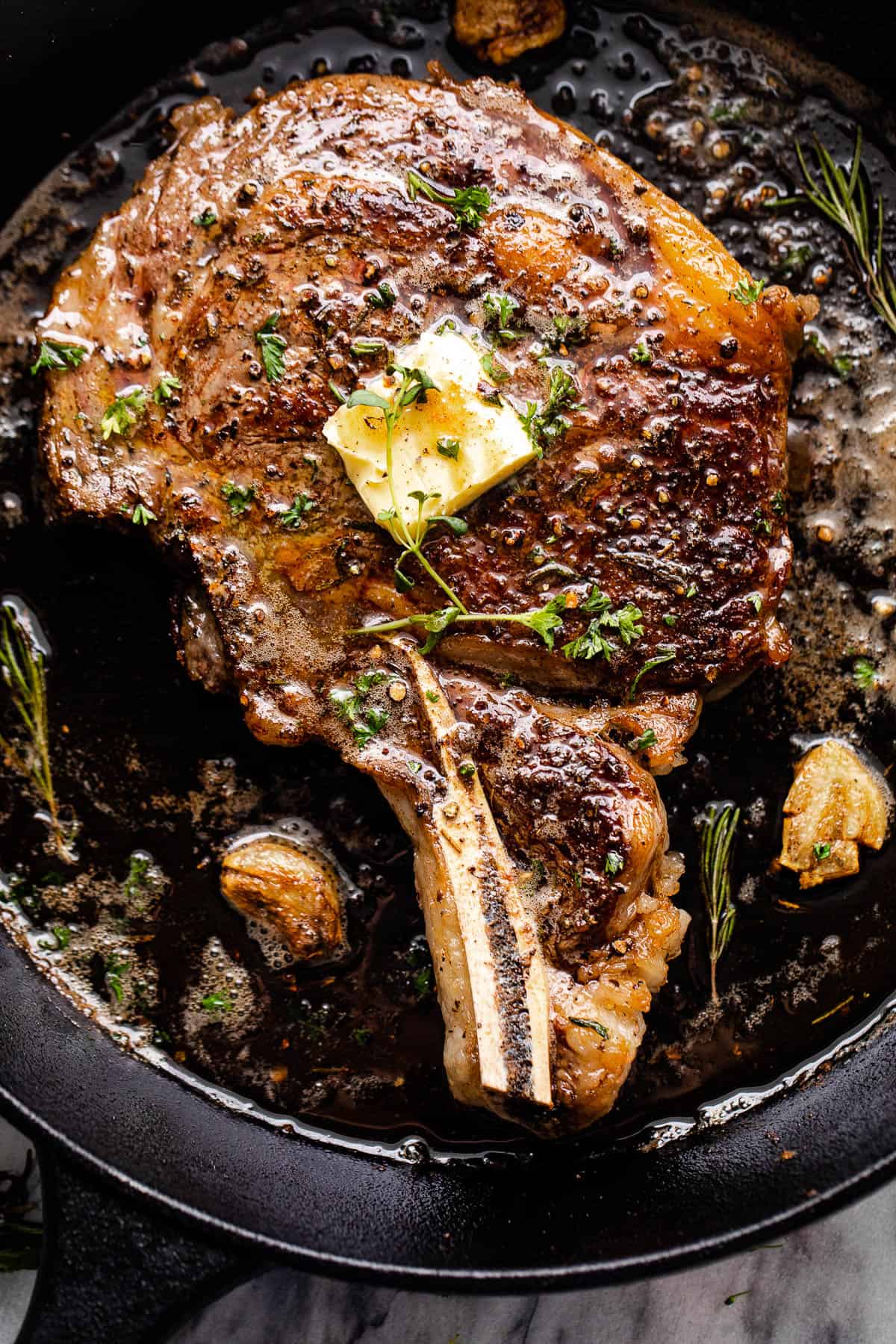
For the ultimate juicy, beefy flavor, a ribeye is the best choice! My recipe for Ribeye Steak is the epitome of tenderness and flavor. Perfectly cooked to a juicy deliciousness, this steak is wonderfully seasoned and offers a delicious punch of flavors with every bite. The good news is that you don’t need a fancy restaurant reservation to savor a top-notch steak. With the right ingredients and a bit of skill, you can whip up the ultimate ribeye right at home.
This dish lets the steak be the star. Perfectly seared, it pairs nicely with its natural juices, fragrant herbs, and that hint of garlic. Cooked in a cast-iron skillet, the rib eye is basted with flavorful garlic butter and makes one memorable steak dinner.
What Is Rib Eye Steak?
Ribeye steak is a boneless rib steak that comes from the rib of the animal. It is one of the “primal cuts” of meat. Ribeye steak is fine and tender with a wholesome, beefy flavor similar to chuck. You will see the name of this steak spelled two ways: “rib eye” and “ribeye.” Both are correct and refer to the same cut of meat.
Why You’ll Love This Ribeye Steak Recipe
- Juicy Flavor: Ribeye is renowned for its marbling, which means every bite is juicy and melts in your mouth.
- No Fancy Equipment Needed: With just a cast-iron skillet and some basic kitchen ingredients, you’re good to go. No need for extravagant grills or machinery to make a ribeye steak at home.
- Quick & Easy: Despite its gourmet appeal, this ribeye doesn’t take long at all, and it’s perfect for a weekend dinner, a steak and eggs breakfast, or even a mid-week treat.
- Budget-Friendly: By cooking a rib eye steak at home, you can recreate a fine-dining experience without the hefty restaurant bill.

The Ingredients
You don’t really need any fancy ingredients to make this recipe for cooking ribeye steak, but I do like to use fresh herbs and the best-quality steak I can find. If you have to use dried herbs, though, no worries! It’ll still be delicious.
- Ribeye: You’ll need a pound or so of bone-in ribeye steak, 1-inch to 1-1/2 inch thick.
- Kosher Salt & Ground Pepper: To taste
- Rosemary: You’ll need to strip the leaves off of a stem or two of fresh rosemary and give it a chop; about 2 teaspoons.
- Fresh Thyme: Again, strip the leaves from the stem and chop them, this time about 1 teaspoon.
- Butter & Oil: You’ll need a couple of tablespoons of unsalted butter and one tablespoon of olive oil for sauteing. You can also use vegetable oil or your favorite high-smoke-point cooking oil.
- Garlic: No need to mince the garlic here, just smash three cloves and peel away the papery outer skin.
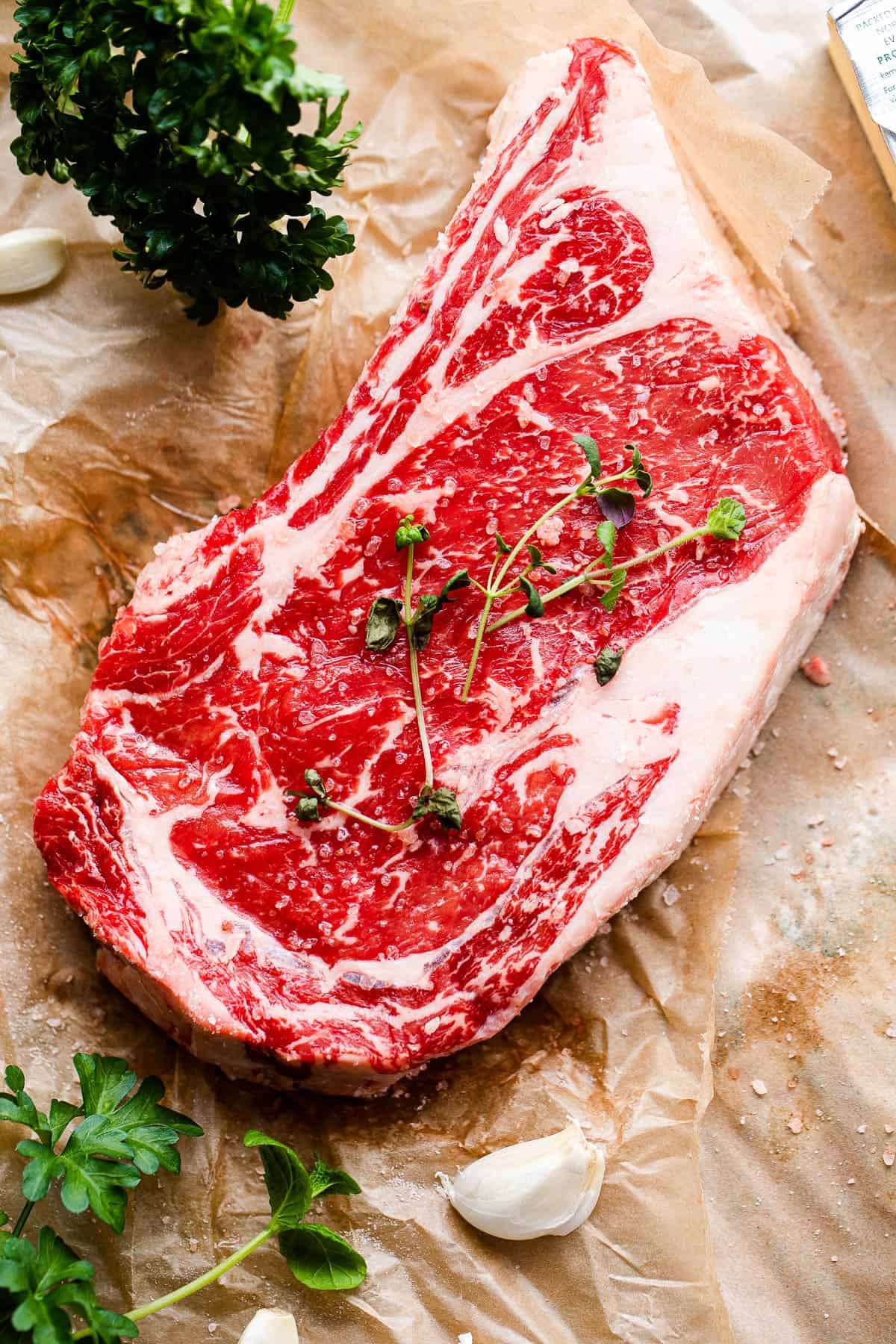
How To Cook Ribeye Steak
- Bring Steak to Room Temperature: Take the steak out of the fridge and pat it dry with paper towels. Salt it liberally on both sides. Let it sit on the counter at room temperature for 30 minutes. Don’t skip this part.
- Season The Steak: Sprinkle the steak with pepper, rosemary, and thyme; using your fingers, press the herbs down into the meat.
- Cook First Side: In a cast iron skillet over medium heat, heat the olive oil. Add the butter and swirl it around. Place the steak in the skillet, and cook for 5 minutes.
- Cook Second Side: Turn the steak over; add the smashed garlic to the skillet, and continue to cook 5 more minutes. Tilt the skillet and spoon the butter drippings over the steak, occasionally.
- Check Doneness & Rest Steak: Check the internal temperature of the steak before removing it from the heat. For a rare steak, the internal temperature should read 120˚F; for medium-rare, it should be around 125˚F to 130˚F. Remove from the heat, and transfer the ribeye to a cutting board; let it rest for 10 minutes before cutting and serving with Alfredo pasta!
Cooking Temperature for Steak
Timing the steak for doneness depends on the thickness of the steak, the thickness of the pan, and the stove itself. The times will always vary. For that reason, grab an Instant Read Meat Thermometer and follow this USDA guide for help:
- For a RARE steak, aim for an internal temp of 125˚F to 130˚F.
- For MEDIUM RARE, cook it until it’s between 135˚F and 140˚F.
- If you’re going for MEDIUM TO MEDIUM-WELL, target 145˚F to 150˚F.
- And for those who like it WELL DONE, get it to 160˚F.
Cooking Times For Steak
If you don’t have an instant-read meat thermometer, follow these guidelines, but keep in mind that the cooking time for steak varies based on how thick the steak is and how well you’d like it cooked.
- Rare: 4 to 5 minutes per side.
- Medium-Rare: 5 to 6 minutes per side.
- Medium: 6 to 7 minutes per side.
- Medium-Well: 7 to 8 minutes per side.
- Well Done: 8 to 9 minutes per side.
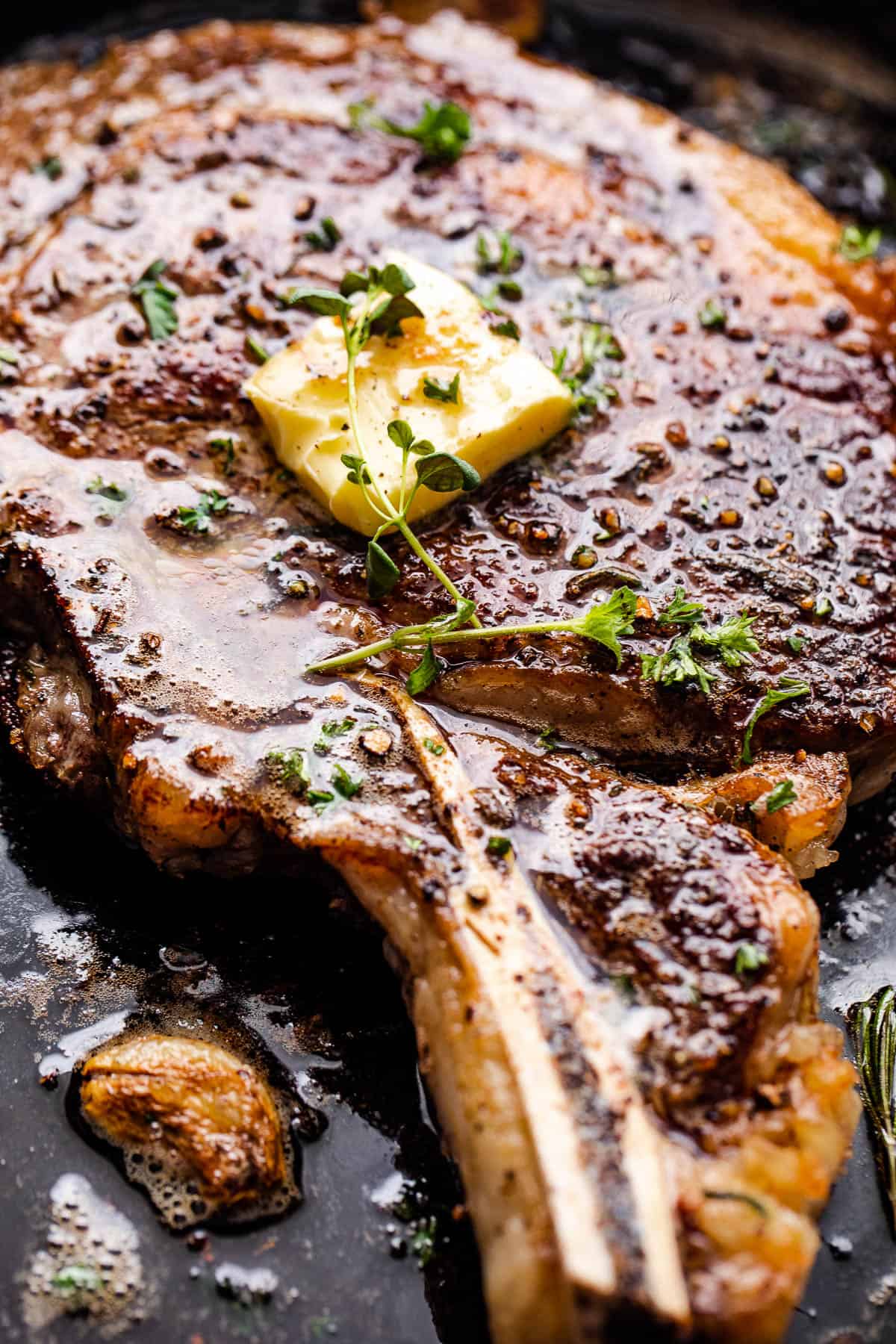
How to Choose Steak
- Thickness: It’s best to choose a steak between 1 and 1.5 inches. Thinner steaks, like skirt steak for peperonata, cook quickly but can be tricky to perfect the doneness. On the other hand, thick steaks, similar to a New York strip steak, are incredible but can be more challenging to get just right; they’ll almost always be overcooked on the outside or very rare in the center.
- Marbling: Very lean ribeyes may sound great, but they are actually of poorer quality than steaks generously flecked with white fat throughout. That fat, or “marbling,” melts away as the steak cooks and creates a tender, juicy texture.
- Cap and Fat: The cap of the steak is the top section, opposite the thin, boney end. It’s the most tender and flavorful part of the steak, so look for ribeyes that have a generous amount of cap meat. Between the cap portion and the eye portion, which is snuggled against the bone, there should be a small chunk of fat. Look for steaks that don’t have too much fat there; a large, heavy chunk of fat is basically “wasted space,” that won’t be eaten or tenderize the meat.
Recipe Tips
For a successful rib eye steak dinner, follow these simple tips and tricks, and you’ll be ready to make steaks at home anytime – whether it’s ribeye, a tomahawk steak, or a tender filet mignon!
- Get the Pan Hot: It’s important to have the pan nice and hot so that it will sear the steak.
- Let It Rest: Before cooking, let the steak come to room temperature. This ensures even cooking.
- Dry It Out: Always pat your steak dry with paper towels before seasoning.
- Season Generously: Don’t be shy with the salt and pepper. Seasoning is key to bringing out the steak’s flavors.
- Avoid Overcrowding: If you’re cooking multiple steaks, make sure there’s enough space between them. Overcrowding can reduce the pan’s temperature and prevent proper searing.
- Instant-Read Thermometer: It ensures that meat is cooked to the desired level (e.g., rare, medium, well-done) by providing an accurate internal temperature reading.
- The Steakhouse Butter Trick: You can add an extra dimension of flavor to your ribeye steak by placing a pat of butter on top while it rests. The butter will melt onto, and almost into, the steak.
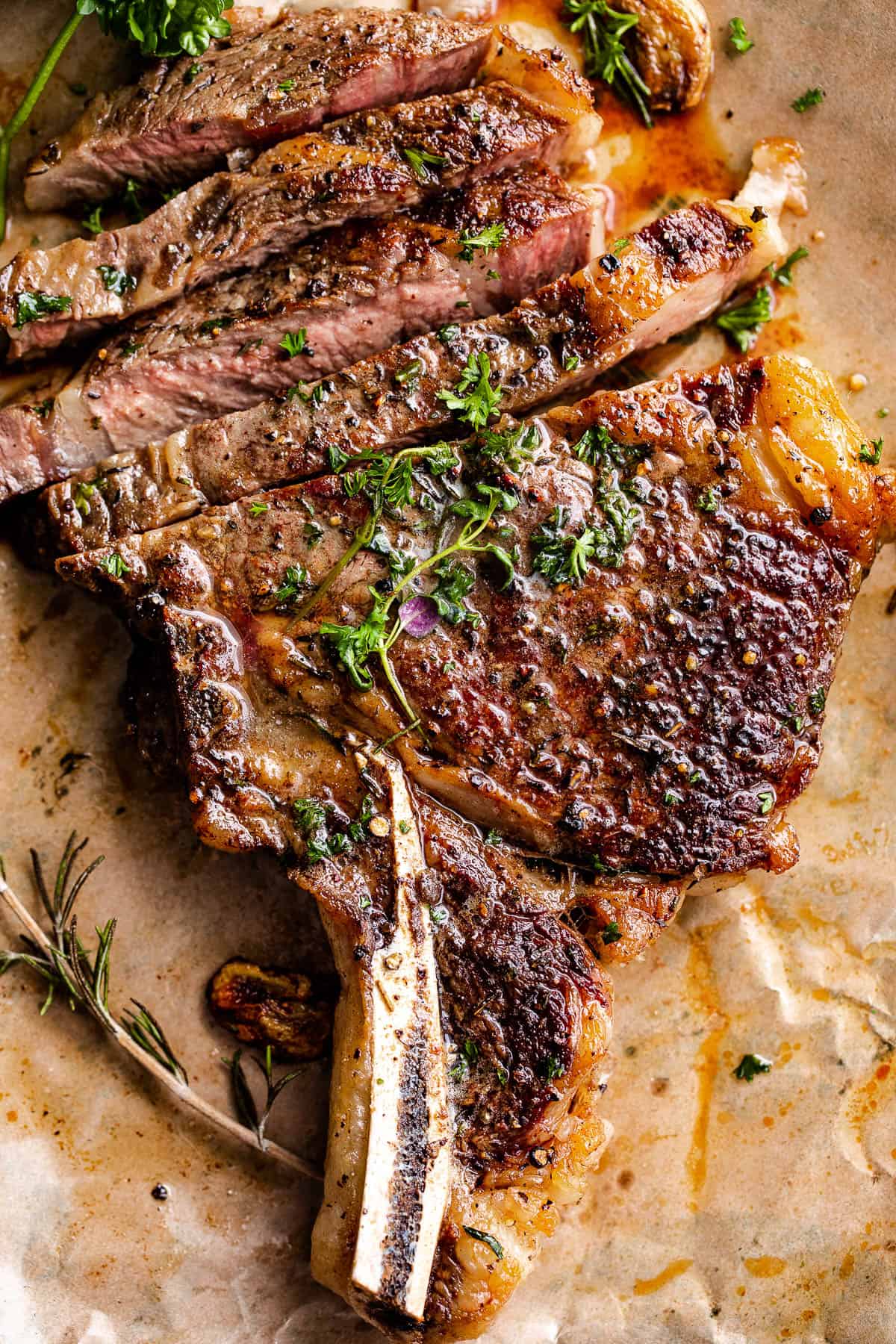
Serving Suggestions
My strawberry avocado pasta salad is a fresh and flavorful salad that will add a nice pop of sweetness to your date night dinner with a side of cheddar bay biscuits. For a Latin spin, drizzle the ribeye steak with chimichurri sauce from my churrasco steak recipe.
You won’t believe how well this spinach, feta and potatoes au gratin goes with pan-seared steak. It’s a cheesy, creamy casserole that no one can resist!
If you want an ultra-tasty side dish to pair with your ribeye steak, these crab stuffed mushrooms or my air fryer crab cakes are sure to hit the spot. For a low-carb bread side, try this cloud bread recipe.
Storing Leftovers
Place leftover steak along with the pan juices into shallow, airtight containers or food storage bags. Keep refrigerated for up to 3 days or freeze for up to 2 months. To reheat, first, thaw leftovers overnight in the refrigerator (if frozen). Then, bring the meat to room temperature on the countertop. Finally, reheat in a covered skillet over low heat until it reaches the correct internal temperature of 120˚F, or a little above.
Steak Dinner Ideas
Pin this now to find it later
Pin It
Ribeye Steak Recipe
Ingredients
- 1 pound bone-in rib eye steak, 1 to 1-½ inch thick
- Kosher salt, to taste
- freshly ground black pepper, to taste
- 2 teaspoons chopped fresh rosemary
- 1 teaspoon fresh thyme leaves
- 2 tablespoons unsalted butter
- 1 tablespoon olive oil
- 3 cloves garlic, smashed
- chopped fresh parsley, for garnish
Instructions
- Take the steak out of the fridge, pat it dry with paper towels, and salt it liberally on both sides. Let sit on the counter (at room temperature) for 20 to 30 minutes. Room-temperature meat will produce juicier, more evenly cooked steaks.
- Season the steak with pepper, rosemary, and thyme; press down the herbs into the meat using your fingers.
- Set a 10-inch cast iron skillet over medium heat. You can also use a heavy-bottomed skillet.
- Heat up the skillet; then add the butter and olive oil. Melt the butter and swirl it around to cover the entire bottom of the skillet.
- Add the rib eye steak to the skillet and cook for 5 minutes or until browned on the bottom.
- Turn the steak over; add smashed garlic to the skillet and continue to cook for 5 more minutes for a rare steak, basting the steak with the butter drippings. Tilt the skillet so it’s easier to spoon the butter drippings over the steak.
- Check the internal temperature before removing it from the heat. For a rare steak, the internal temperature should read 120˚F; for medium-rare, it should be around 125˚F and 130˚F. Thicker steaks will take longer to cook through.
- Remove from heat and immediately transfer the ribeye steak to a cutting board; let rest for 8 to 10 minutes before cutting and serving.
- Top with parsley and serve.
Notes
- Hot Pan: Ensure the skillet is hot for a proper sear and juiciness.
- Use a Thermometer: An instant-read meat thermometer allows quick and repeated checks for perfect doneness. The USDA recommends cooking beef to at least 145˚F internal temperature; however, according to culinary professionals, ribeye steaks are optimally cooked at the specified temperature(s).
- Rest the Steak: Let the steak sit at room temperature before and after cooking for evenness and juiciness.
- Avoid Overcrowding: Ensure each steak has space for a good sear.
Nutrition
Nutritional info is an estimate and provided as courtesy. Values may vary according to the ingredients and tools used. Please use your preferred nutritional calculator for more detailed info.
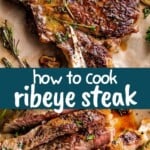








My whole family begs me to make this steak recipe
That’s amazing to hear! Thank you so much! I am very glad you and your family enjoyed it! 🙂